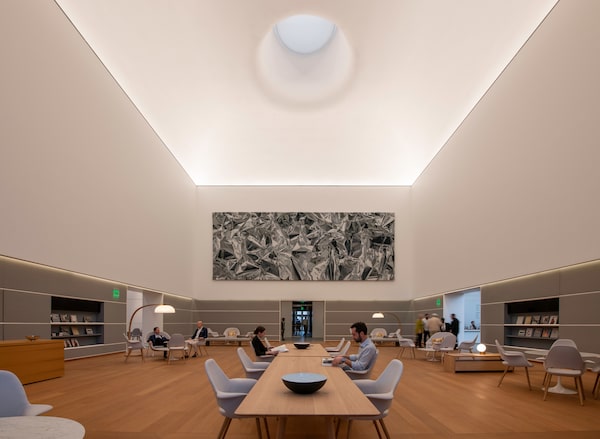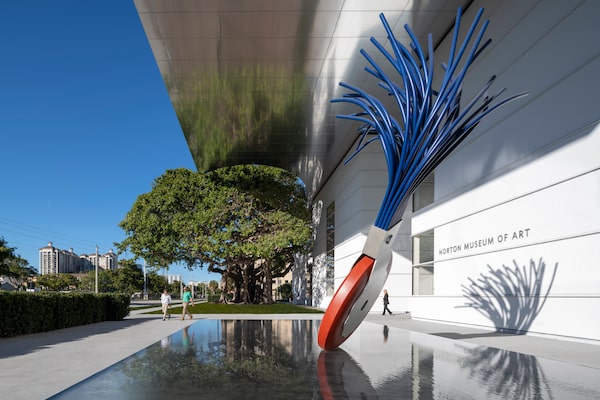
The Norton Museum of Art Shapiro Great Hall.Nigel Young/Handout
“How many museums give pride of place to a baobab tree?” As the British architect Norman Foster put the question with a sideways grin, I could see the tree he was talking about: The many-trunked behemoth in question, 80 years old, towered right outside the new front window of the Norton Museum.
Foster was here, as was I, to mark this gallery’s new expansion by his firm, which enlarges the place both physically and in terms of stature. Here in West Palm Beach, Fla. – not a place particularly known as a cultural destination – the Norton now boasts a refined and comfortable building to house its more than 7,000 pieces of American, Chinese and contemporary art.
What’s new starts, surprisingly, outdoors. “Sometimes as a stranger to a place you become aware of the differences,” the London-based Foster told me. And in the Palm Beaches, “everyone in a house has a nice garden,” he said. “But at the museum, there wasn’t any celebration of nature and the outdoors.”
Now there is – a shady garden that scatters sculptures by Keith Haring and Joel Shapiro between elephant palms, and Bahamian trumpet and gumbo limbo trees.

The Norton Museum of Art gardens looking east.Nigel Young
In South Florida, where there’s often a weirdly strict boundary between the hot outdoors and air-conditioned chill, this is precious.
Inside, the gallery now has some of the most beautiful Modern rooms in the region. “This institution, we were a 12-year-old Volkswagen,” director Hope Alswang said, “and somebody just handed us the keys to a Lamborghini.” On one level, that metaphor makes sense: The new museum was expensive, and it’s fed by gifts of money and art from people who can afford a Lambo or three. It is officially the Kenneth C. Griffin Building, named after a hedge-fund manager who recently made headlines for buying a $238-million New York penthouse.
But the more apt metaphor is a Mercedes: The building is unflashy and rational, with nothing out of place. The Pritzker Prize-winning Foster and his team have created a new building that is consistent in its right angles, Classical symmetry and white-on-white-oak palette. The grandest space, the Shapiro Great Hall, holds just one stunning work of art – Eikón, a long tapestry by artist Pae White, which pictures crinkly aluminum foil in its cotton warp and weft. Sip your espresso and consider it.
The museum is, by Florida standards, ancient: It was founded in 1941, by industrialist Ralph Norton and his wife Elizabeth. The original building, a severe Art Deco edifice, was by the local architect Marion Sims Wyeth (who also originally designed the nearby Mar-a-Lago.)

The Norton Museum of Art new Heyman Plaza.Nigel Young
Foster and Partners’ addition is relatively small – “but you have the sense of a new museum,” Foster said. “The task was to bring a coherence to the whole thing” – which they’ve done. The 1941 building has been cleaned up and connected to a new sequence of galleries that are comfortable and logical to navigate. “With what was here, we took the best of what we found,” the architect Spencer de Grey of Foster and Partners told me. The old herringbone wood floors, long covered in carpet, were revealed and refinished. They look great. And the eight (!) exhibitions on show, ranging from an exploration of “camera-less” photography to 19th-century watercolours, generally look great.
The museum’s building and grounds are a respite for the senses after a day at the beach or a week playing golf in sun-baked suburbia. Foster’s rigorous geometry feels totally foreign, but it isn’t entirely. As the architect pointed out, the most famous buildings in the region – Miami Beach’s Deco – are coloured boxes. The Norton is like their quieter, British cousin.
But the one place where things get wild is back outside, on South Dixie Highway. This is where the museum shows off with a great big sign facing the speeding traffic, and that baobab tree. A flat steel canopy overhead curves back out of the way of the venerable tree, shimmering with muddy green reflections. It’s nature and art, in a beautiful balance.
The writer travelled as a guest of the Norton Museum. It did not review or approve this article.
 Alex Bozikovic
Alex Bozikovic